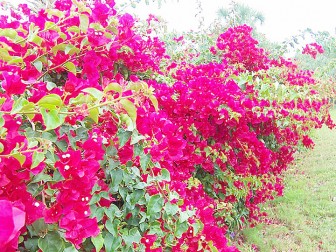If your garden occasionally begins to look like a paddy field or you get pools of water which lie on the ground for quite long periods of time, then you almost certainly have a drainage problem. It may be caused by soil which is almost pure clay becoming as hard as iron in the dry season and almost impenetrable to moisture in the rainy season; or, if you’re really unlucky that you are affected by being below sea level. It’s really bad news for the gardener and thank goodness occurs only rarely along the coastal regions of Guyana. Heavy loams are often confused with clay, but the improvement of such soils amounts to more or less the same treatment which is not as difficult as many people believe.
Clay soils and heavy loam soils are mainly comprised of very fine particles which hold a great deal of water in the rainy season. They drain very slowly, unlike sandy loams which drain (and warm up) quickly. As a consequence they become easier to work much more rapidly than the heavier types of soil. Now it is a fact that the drainage of heavy soils such as clays can be improved quite quickly by the addition of organic matter. Usually this takes the form of garden compost which has been saved and rotted down. The time to add this compost has to be judged quite nicely. It’s heartbreaking to do it when the ground is as hard as iron. It’s better to add compost when you can add it without breaking your back. This is likely to be towards the end of the rainy season or even at the beginning when the ground is beginning to soften up.
In colder climates the end of autumn is the best time to add compost, because the cold and frosty weather causes the clay to break up. In Guyana the problem requires a little more ingenuity.

One other method to adopt is letting the grass cuttings ‘fly’ – that is you stop collecting grass in the grass box and just allow them to form their own ‘mulch’ on the surface. Not that you’ll have to cut the lawns very often in the kind of dry weather that one has in Guyana.
Hedges

There is a downside with certain hedges. Bougainvillea can be an infernal nuisance for the simple reason that it gets too tall when planted in a small garden. It is a glorious sight in a large garden when it can be allowed to develop to its full stature, but it can look awful in a small garden when has to be cut down viciously to make it fit in. This applies to many shrubs you care to think about which cannot be allowed to develop in a carefree way and still screen you from an eyesore in your neighbour’s yard. In the end you have to decide what you want your hedge to do for you. Is it to be a barrier full of spines and prickles to protect you from two-legged as well as four-legged animals, a screen which gives you privacy, a floral display for some of the time or for most of the time, or something that will give shelter and protection from strong prevailing breezes and give shelter to wild life without which no garden is a proper garden at all.
Until next week may your God be with you wherever you may be.





